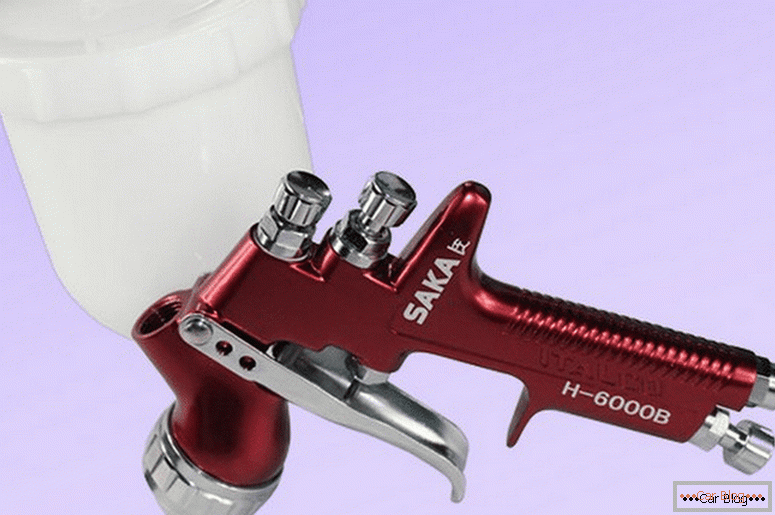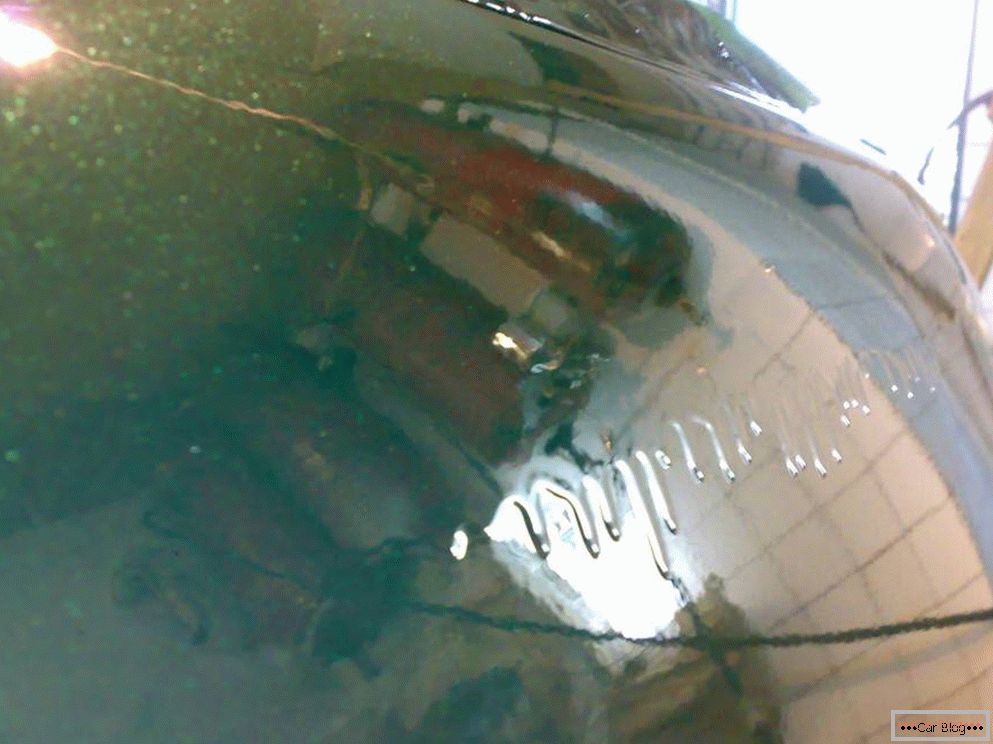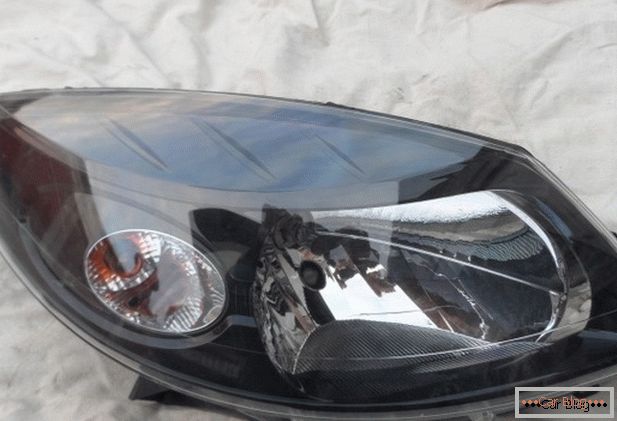Power steering (abbreviation GUR) - familiar to most motorists. It refers to the main part of the steering mechanism. In the past, driving a car was a very tedious task, as it was necessary during the sudden change of the trajectory to strain to turn the steering wheel, this was especially problematic on trucks. Designers who always improve parts for convenience, comfort and safety, paid attention to it, therefore the steering wheel became not an exception. To whistle the effort to a minimum, was invented power steering system.
Its main purpose, as it was, was conceived in favor, comfortable control of the machine while driving, but there are other equally important services, such as:
- preservation of "feedback";
- road safety;
- safety enhancement. That is, there is control over the vehicle after damage to the front tire and the ability to evade a collision;
- allows you to "feel" the roadway and creates a kinematic tracking effect;
- reduces the gear ratio of the steering system, which increases maneuverability;
- prolongs the service life of parts of the steering unit.
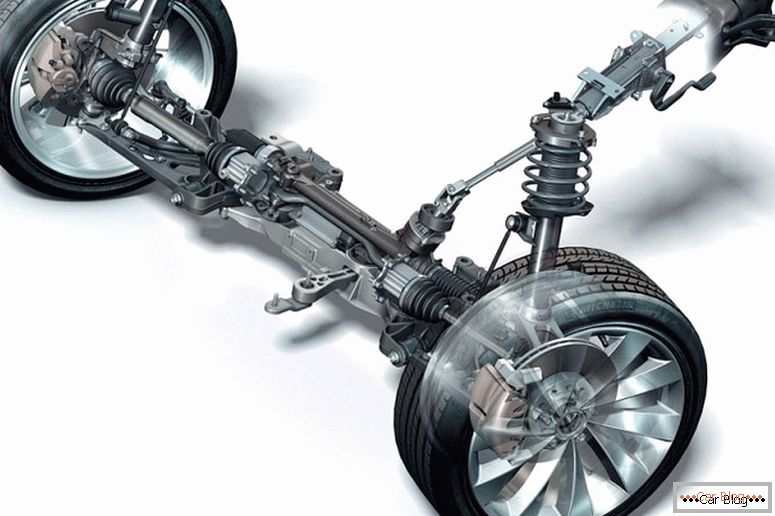
Power steering
By design, power steering is compact and can absorb shocks, with vibration extending from the roadway to the steering wheel. During use, they are completely silent. With their appearance, the ride became trouble-free, even the number of parking spaces decreased by half. Having in the car power steering complex turns and reusable maneuvers began to be given a bang. However, many people do not know the principle of operation of the established full power steering, and when the vehicle leads away, they are trying to resolve the situation on the "similarity-collapse" by doing this incorrectly. Naturally, seasoned razveschiki can easily set the angles of installation of the wheels for the correct "resistance" to drive the car to the side if the power steering is faulty.
In order for the device to fail and reliably perform all the prescribed tasks, it is necessary to visit service centers for diagnostics in a timely manner.
Content
- 1 Step into the story
- 2 Types of power boosters
- 3 Power steering: device and principle of operation
- 4 Device power steering pump
- 5 Maintenance of the hydraulic booster
- 6 Disadvantages of GUR
Step into the story
Since the first cars were not heavy and with narrow wheels, it didn’t take much effort to turn the steering wheel. But with the advent of the first trucks to rotate the wheels of a multi-ton truck, it turned out to be quite laborious, if not feasible. And then it was necessary to reduce the diameter of the “donut” and change the structure of the steering rack. Invented and patented the hydraulic booster for the first time Frederick Lanchester. First, the benefit of auto mechanics has spread only to mining dump trucks, fire trucks and trucks. The precursors of pneumatic amplifiers were simple and were fed from the compressor of already existing pneumatic brakes.
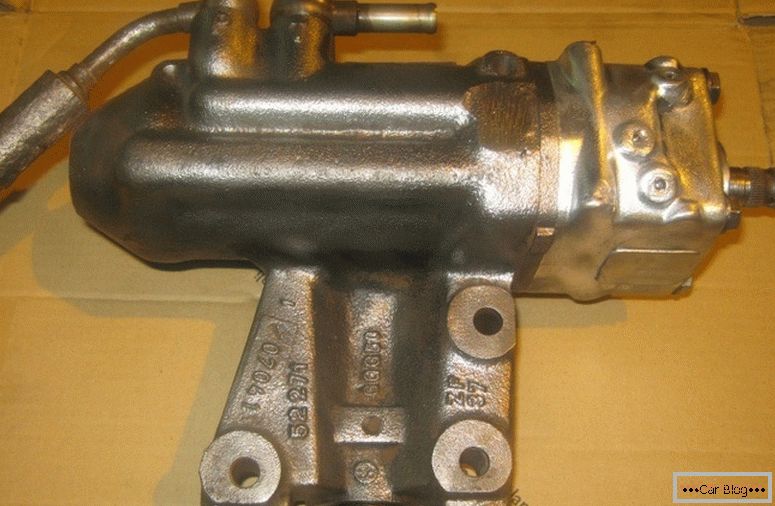
Only in the 20s of the 20th century, Rolls-Royse equipped the Phantom business card with a hydraulic booster. Understandably, hydraulic amplifiers were more complicated than existing pneumatic ones. But the attempt was unsuccessful, and the experiment was postponed for several years. Further, already during the Second World War, the British re-introduced the work of the power steering, installing it on large armored vehicles. And five years later, the technology firmly entrenched in the European and American automotive industry. Since then, the device has not undergone fundamental changes. Today, the diversity of the GUR system is impressive, in addition to it there are two more amazing technologies that facilitate the operation of vehicles - Electric Power and Electrohydraulic.
Varieties of power boosters
To argue that the power steering in the standard version is extremely necessary not. It is useful only at certain points. Of course, it makes it possible to maneuver with success in urban conditions, but on the open highway at high speed there is no benefit from it at all. With increasing speed, you stop “feeling” the road, which is popular especially in winter.
In order to somehow cover the flaw, it was undertaken to establish a steering rack with a variable relative relation. However, the attempt was unsuccessful rescued the situation of electronics, which made a modification of the hydraulic booster. It combines not only comfort, but also the information content of the steering wheel. The electrohydraulic power steering (EGUR) serves on the same principle, the differences are the increase in the electronic unit and the actuator electro-valve.
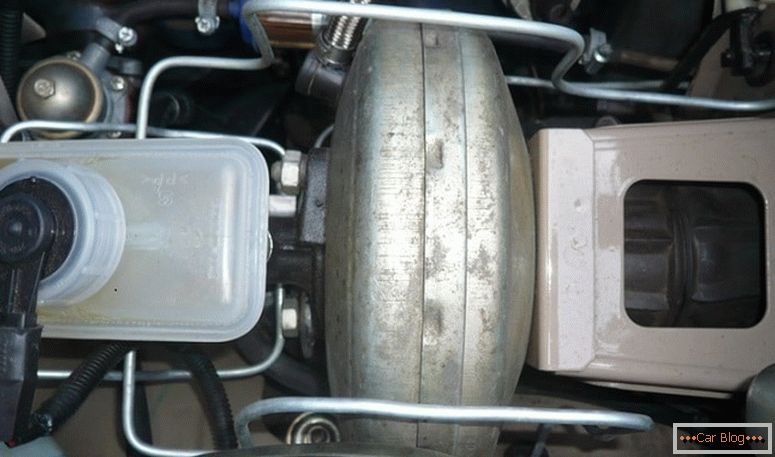
Power steering tank
Power steering: device and principle of operation
To understand how the GUR design works, consider the power steering scheme, consisting of such parts as:
- Power cylinder double action placed in the steering part, where it stands between the parts of the drive and body. It is connected with a spool control unit and a hydraulic cylinder. The main achievement is the conversion of fluid pressure to the movement of the piston and rod, helping to move the wheels in the desired direction.
- Pump attached to the engine, and its drive from the crankshaft is a belt drive from the crankshaft pulley. Required to form oil pressure. Blade-type designs are more common, because they have good efficiency.
- Working fluid contained in the tank, there is also a filter, a lid with a probe for measuring the level. The function of the oil is to lubricate the friction parts and transfer force from the pump to the hydraulic cylinder.
- Tankfilled with hydraulics to keep it clean inside there is a filter.
- Pressure regulator or valve - this is a precision (highly resistant) and simple node according to the scheme. It is a pressure reducing valve. Located on the details of the steering gear or on the same shaft with the steering element. His task is to distribute the hydraulics in the desired cylinder cavity or back to the tank. Required to control the engine crankshaft speed so that it does not increase the permissible pressure rate of hydraulic fluid. The spool valve is a complex part consisting of a torsion and a spool valve. When inside the valve turns, the valve is called a rotary valve, and if it moves progressively, it is axial.
- Connecting hoses high and low pressure bring together the hydraulic cylinder, pump and distributor. Also, hydraulic fluid circulates through them from the tank to the pump and back, returning from the distributor. Where it is necessary to create mutual mobility of nodes, flexible hoses are used.
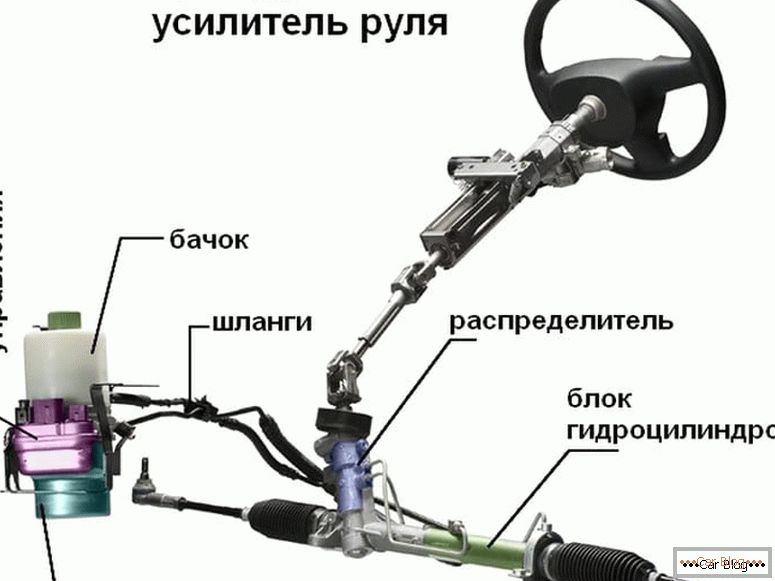
The principle of work at GUR and EGUR is similar
The principle of operation of the power steering with both axial and rotary distributor, based on the movement of the spool when shifting the steering wheel. First, the pump generates pressure in the steering assembly. If the “steering wheel” is twisted in one of the sides, the valve begins to move and closes one of the drain lines, and the working fluid under pressure goes into the necessary cavities of the hydraulic cylinder. Hydraulics with a rod presses on the piston, and it moves the wheels.
When the wheels turn, they direct the valve body in the direction of movement of the spool. And when the valve takes an immobilized state, they begin to restore their normal position of the valve body. From the discharge line, the oil easily passes into the drain. Further, the amplifier simply pumps the working fluid with a pump through the system. At the same time, the wheels are pointing straight. When the wheel finishes spinning, the whole circuit changes and stops.
Even if the hydraulic pump broke down (for example, the drive belt broke off) - this does not affect the control of the vehicle. Because the force from the steering system will go to the distributor case, and then to the wheels with the valve. Through the starting valve, hydraulics will move from one cavity to another and not create obstacles, which will allow you to turn the steering wheel, only with tension. The power steering scheme clearly demonstrates the whole essence of the system.
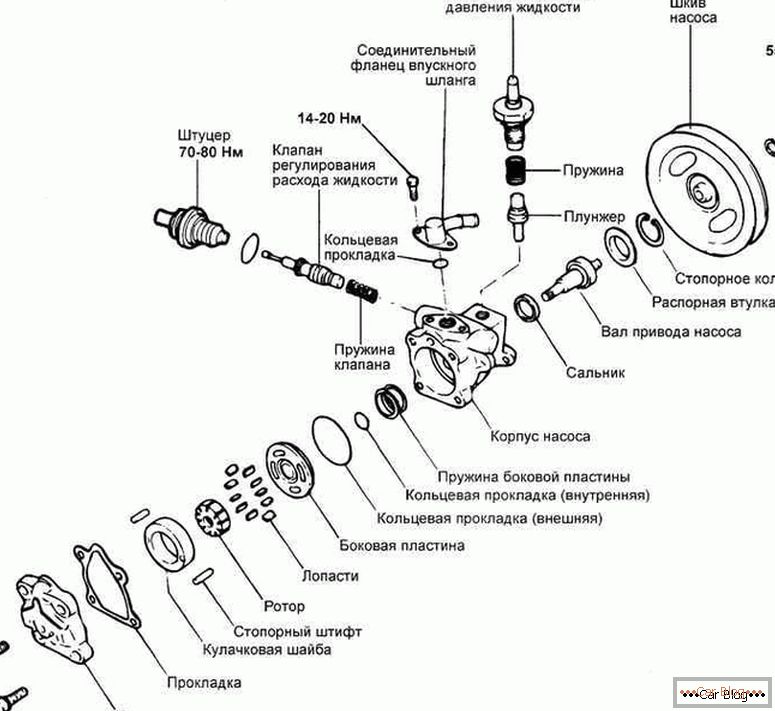
Power steering pump device
During the turn of the steering wheel in the other direction, the distributor feeds oil to the opposite parts of the hydraulic cylinder, respectively, the steering rack goes to the other side and turns the wheels in the right direction. As for the driver, he makes a minimum effort to turn the steering wheel. When the car is without moving the steering wheel to turn, just for this it is necessary that the engine was started.
If the vehicle runs into an obstacle, the repulsive force attempts to turn the wheels. But instead, they move the distributor case with respect to the spool and close the drain line. After that, the hydraulic fluid enters the cavity of the cylinder, and the piston sends force to the wheels going in the opposite direction. Fast response causes the wheels to lock and cannot turn. Due to the fact that the spool stroke is small (about 1 mm), the vehicle practically does not change the direction of movement. GUR shields the driver's hands from colliding with the steering wheel spokes when it hits something. Small shocks are still felt - this is due to the fact that pressure rises above the jet washers.
“Sense of the road” is the feedback from the steering wheels through the amplifier to the steering wheel. Tells the driver in what conditions the turn. Feeling a power follow-up action, the machine can be controlled in any weather. Therefore, as part of the design attach jet washers, plungers or cameras. One of the washers at high pressure, trying to put the valve at the starting point, from this steering wheel works "tighter".
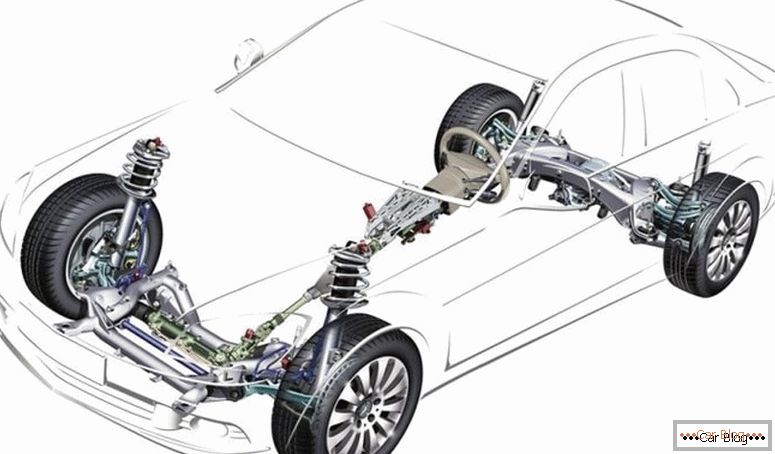
Расположение ГУРа
Power steering pump device
Blade pump assembly is divided into types:
- Bladed.
- Gear.
The pump mechanism consists of a housing, a rotor and an o-ring. The pump has a V-belt drive from the crankshaft pulley. The pulley is matted at the end of the outer shaft, located on the ball and needle bearing. The rotor is located on the shaft splines, the blades are freely installed in its grooves. The stator is attached to the pump casing with a distributor disc and cover. The inner surface of its body has a complex shape. The blades are installed in the rotor, where several slots are provided parallel to its longitudinal axis. These blades under the pressure of centrifugal force slightly out of the grooves and contacting, with the inner surface of the housing, create closed chambers.
The inner surface of the housing is arranged in such a way that when the volume from the rotation of the rotor decreases between them the oil is compressed. If a hole appears, the hydraulic fluid rapidly exits the blades. The process of suction fluid is the opposite. By itself, the pump must be high-performance to ensure the shaft turns as quickly as possible. It is started by transfers from the engine:
- Gear wheel.
- Repeat.
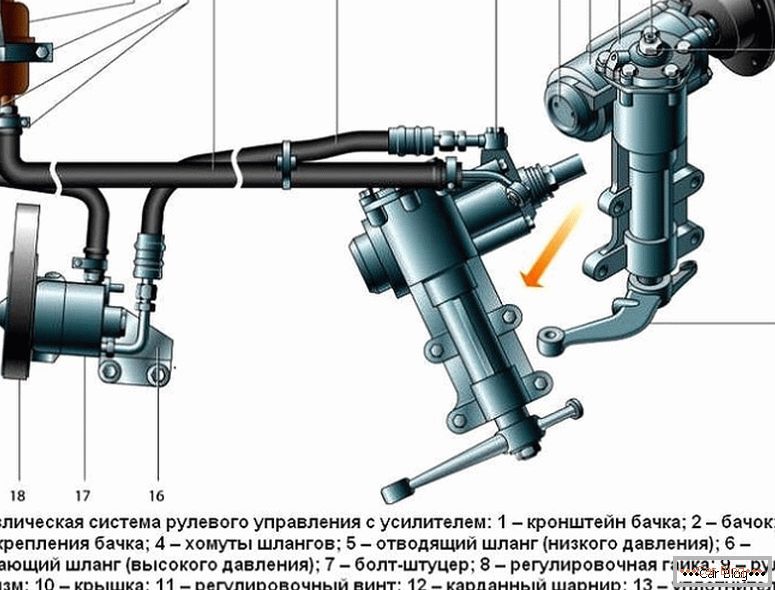
Power steering combined with steering gear
Maintenance of the hydraulic booster
- Very often, the leading belt causes the driver to break down, so you need to monitor the level of its tension.
- It is necessary to monitor the level of oil in the tank, if its rate is below normal, it is necessary to top up. A shortage of oil will cause the pump to fail. What is suitable hydraulic fluid most need to learn from the instructions or in a specialized store.
- Once a year, change the filter element in the tank.
- It is easy to drain the oil; it is necessary to remove the hose and, with the tank lid open, the liquid will spill from the action of atmospheric pressure. Gulf of fresh oil should be with the lid open a couple of times to rotate the steering wheel to the extreme positions, it is necessary that the excess air left the tank.
- Note that on a hydraulic power steering vehicle, you should not hold the steering wheel in the extreme turning position for more than 5–6 seconds - the hydraulic fluid will overheat.
- In addition, it should be from time to time to replace the oil, this is due to contaminants that affect its properties. With the loss of the basic properties of the liquid can damage the seals of the steering rack, and this will lead to a failure of GUR.
- Regularly conduct a visual inspection of the system, as the tightness of the system may be impaired. Hydraulics drifts say repair is required.
- If the hydraulic pump does not work, it is impossible to use the machine for a long time - this will lead to wear of the distributor and breakage of the steering gear elements.

Gulf additive in GUR
Disadvantages of GUR
- You need to view the system every day for defects.
- Nanos works from the motor, thereby taking away some of its power.
- There are no job position adjustment functions for different conditions.
Apparently the cons are not so much.

